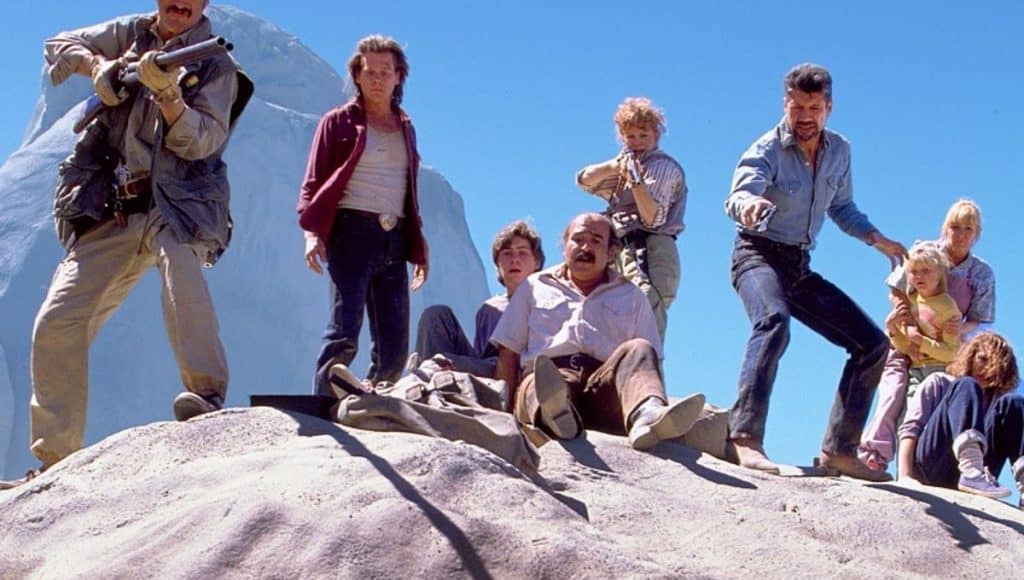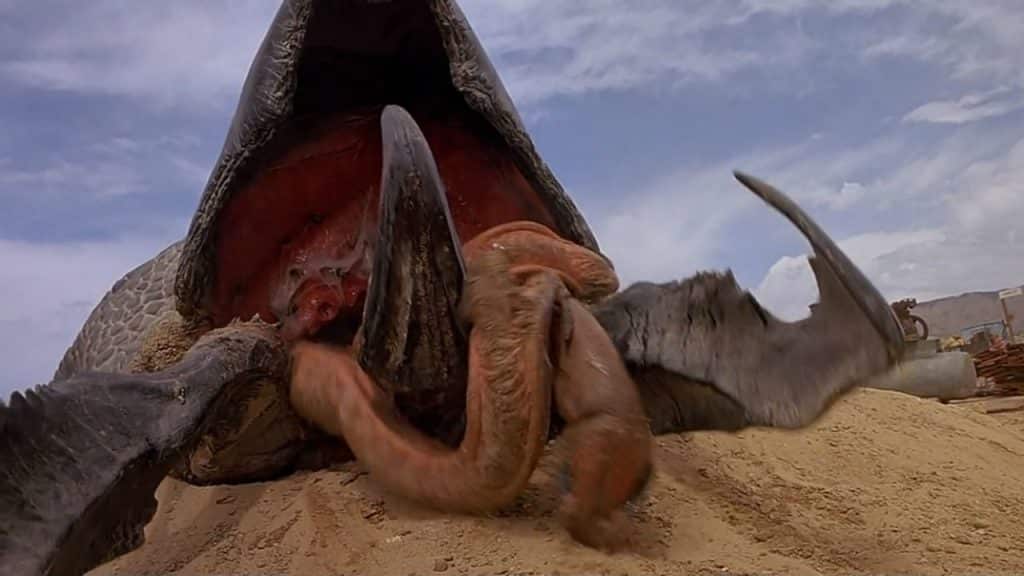Thirty years on, the Kevin Bacon monster-Western remains a giddily effective creature feature.
The first act of Ron Underwood’s Tremors is punctuated with the distinctive sounds of a boy bouncing his basketball, a faulty beer cooler in a general store, and a girl playing on her pogo stick. It’s all seemingly innocuous at first—just the regular sounds of everyday life in the isolated town of Perfection, Nevada.
But then the massacre starts, and the townsfolk realise that they’re being hunted by subterranean monsters that track vibrations in the ground. Suddenly, every whisper becomes loaded with tension, every step becomes precarious, and those familiar early sounds, in particular, become harbingers of death, anticipating imminent mayhem. It’s a wonderfully efficient and surprisingly subtle piece of horror filmmaking, setting the tone for the bracingly lean and mean spectacle that’s to come.
Tremors has never really got the respect it deserves, perhaps because it’s ostensibly so easy to dismiss as nothing more than dumb, “lowbrow” fun. It’s a creature feature comedy about a goofy group of people trying not to get eaten by giant sandworms—there are no symbols, no metaphors, no weighty statements on society. It’s the kind of pure, simplistic escapism that’s so often looked down upon.

But there’s so much more to it than that. Tremors is indeed simple, but it’s also among the most smartly, impeccably constructed films of its kind—compact, tactile, and gleeful in its thrills. It endures as a modest sort of masterpiece—a perfect execution of streamlined genre filmmaking, aggressive and agile, with a striking level of finesse on display in every creative element.
Just admire, for instance, the brilliantly economical production design, which underpins Underwood’s deft and sturdy direction by allowing his camera to smoothly convey information about Perfection and its fourteen inhabitants in just a few shots, without expository dialogue.
Look at the town’s welcome sign, riddled with bullet holes; look at how every vehicle is parked in front of the general store, immediately identifying it as the settlement’s social fulcrum; look at how disillusioned handymen Val and Earl (Kevin Bacon and Fred Ward), at their lowest point, recline in the discarded furniture in the town’s landfill as if it was their own living room—literally at home surrounded by garbage.
And crucially, look at how before the threat of underground monsters has even been introduced, Underwood’s wide shots are already training our eyes to notice the paucity of elevation that makes Perfection such an ideal feeding ground—a few flimsy rooftops, a water tower, and some residual boulders in the distance, are the only visible areas of relative safety in an ocean of lethally flat terrain.
Few films are as visually nimble as this, and fewer still are as tightly written. The pared-down script by Brent Maddock and S.S. Wilson knows exactly where to place its emotional energies, sharply and succinctly sculpting characters with memorable but uncomplicated dispositions. The key relationships and rapports within the townsfolk are distilled down to just the bare essentials.
There’s the bickering, bantering bromance between Val and Earl, with their in-jokes, rituals, and shared sense of one-upmanship; the tentative love story between Val and dorky seismologist Rhonda (Finn Carter); the playfully antagonistic rivalry between Earl and obnoxious teenager Melvin (Bobby Jacoby); and the surprisingly wholesome marriage between gung-ho survivalist gun nuts Burt and Heather (Michael Gross and Reba McEntire), who in the film’s most spectacular scene bombard one of the monsters with a hailstorm of ammunition and the explosive flourish of an elephant gun.
It’s the kind of pure, simplistic escapism that’s so often looked down upon.
The other characters that form the rest of the group are defined just well enough to make us care about whether they survive or not, and that’s just fine. Absolutely no backstory is provided for anybody, and that’s just fine too—after all, no further motivation or deeper psychology seems necessary outside of the primal instinct of not wanting to be gruesomely devoured. Instead, the film relies on the thoroughly committed performances of its ragtag ensemble cast to give substance to these characters, delivering crisply comedic dialogue that never strains for forced laughs or inflated drama.
What the film is known for best, of course, are the Graboids—the bizarre, blind abominations that stalk the inhabitants of Perfection from beneath their feet. There’s a rare level of thoughtfulness in the design of these creatures, intermingling the organic with the aberrational. They have armoured beaks that displace dirt and sand as they burrow through the desert at high speed, and the spines that protrude from their bodies are based on the bristly setae with which real-life earthworms maintain stability as they move.
Beyond those features that make biological sense, there are then the more overtly horrifying portions of the creature’s anatomy. There’s that revolting mouth, which the filmmakers describe as opening like a “grotesque flower”—fleshy and red, lined with gnarly black teeth. And from within that cavernous maw emerge several snake-like tentacles, grasping and coiling, each terminating in its own individual set of devilish jaws. It’s one of the best, most distinctive movie monsters ever created—like pure ugliness in motion.

And there’s so much personality in that motion, too! Drawing upon an extensive arsenal of hand puppets, miniatures, and full-scale models, the film’s team of practical effects artists exploit every trick in the book in order to breathe hefty, violent life into the Graboids. The results are sensational—in every action, there’s a vivid sense not only of the terrifying power and brutality of these beasts but also of their intelligence and temperament.
We see the Graboids strategizing as much as we see them attacking—investigating the surface with their tentacles, actively assessing and engaging with their surroundings. It’s almost as if the film treats them as actual characters as well as straightforward threats, with their own tics and habits, learning and developing all the time alongside our heroes.
That attention to the interplay between human and monster thought processes is a significant part of what makes the film so dynamic in its pacing, so constantly propulsive but never recursive. When there isn’t a physical chase or tussle, there’s tactical activity occurring. A gradually escalating rhythm unfolds as the heroes and the Graboids concurrently attempt to observe and outwit each other—every action met by a counteraction, every solution nullified by another problem.
There’s something almost competitive about the action set pieces, to such an extent that at a certain point Tremors becomes as much about superior ingenuity as it is about survival. What’s more impressive: the heroes’ improvised tractor decoy, or the Graboids’ elaborate sinkhole trap?
I’ve seen Tremors innumerable times, and each time I find it impossible not to be amazed all over again by the lovingness and consummate assuredness of the craftsmanship, found even in the smallest of things. It’s a perfect genre movie, made entirely without irony or pretension, every frame of which is rich with energy and detail.
Underwood would never again in his career be so precise with his compositions, so purposeful with his camera movements. But here he gives us a smorgasbord of moments to savour, in a film whose simplicity contains unexpected variety. Comedy, horror, romance, action, adventure, and hangout movie—Tremors has it all.